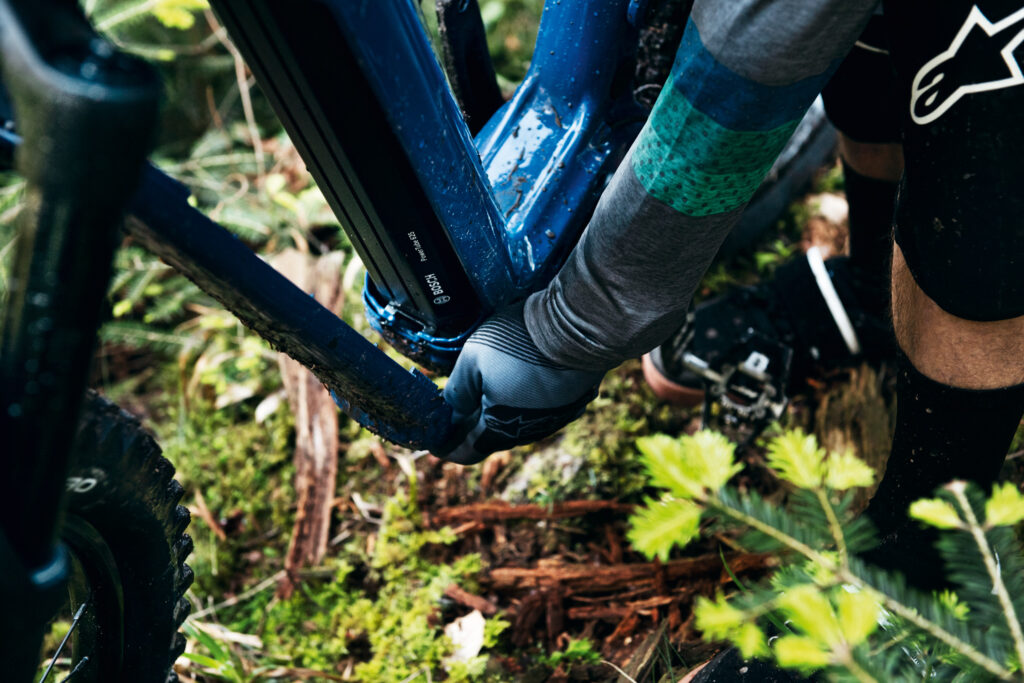Battery size is a tightrope that e-bike manufacturers have to walk. A battery is the heaviest component of the e-assist system, and it is a major factor in how much range you get out of a full charge.
Some companies try to squeeze efficiency out of smaller, lighter batteries paired with lightweight motors that draw less power. Others opt for full-power motors and big batteries, weight be damned. Which option is best? A lot of it comes down to rider preference, but unsurprisingly, there are oodles of options on the market.
Common E-MTB Models Battery Capacity
Off the top, if you’re trying to get a handle on battery capacity on any type of e-bike, look at its watt-hours or “wh.”
| Bike | Battery Capacity | Torque |
| Bulls Copperhead Evo AM | 750wh | 85nm |
| Specialized Turbo Levo | 700wh | 90nm |
| Cannondale Moterra Neo | 625wh | 85nm |
| Giant Trance X Advanced E+ | 625wh | 85nm |
| Orbea Rise | 360wh | 60nm |
| Trek Fuel EXE | 360wh | 50nm |
| Specialized Levo SL | 320wh | 50nm |
Wh means exactly what it sounds like it means: If you have a 750wh battery, and your motor produces 750 watts continuously (that’s a lot!), you’ll get one hour of life; 375wh will be good for two hours. That’s the math on paper, but there are many variables at play, such as motor efficiency and rolling resistance, so don’t overthink it.
However, in the table above you can, for example, compare the Cannondale and the Bulls bikes because both are equipped with Bosch Performance Line CX drive units. You can expect the same efficiency and performance from the motor on either bike. It’s not a perfect apples-to-apples comparison due to variations in spec and frame material that contribute to overall bike weight, but as you can see, the Bulls has a battery with 75wh more capacity.
Naturally, a motor that delivers more torque consumes more battery.
Things get interesting when you look at the battery size in conjunction with the torque. Returning to that table above, you can see the direct correlation between battery spec and torque spec. Naturally, a motor that delivers more torque consumes more battery. This is why full power e-MTBs almost always come with batteries that are at least 600wh. Some are as large as 900wh!

Also consider the overall bike weight. Even if your trails are pan-flat, the motor will have to work harder to accelerate more mass. And especially if your trails go straight up the mountain, weight will play a significant role in battery life.
For this reason, some e-bike manufacturers spec a smaller battery on the smaller sizes in their bike ranges. Trek does this with its Rail e-MTB, opting for a 625wh battery on a Small frame while the other four sizes get 750wh Bosch Powertube batteries. The reasoning is likely that shorter, lighter riders will ride smaller sized bikes and should get similar range from a smaller battery. From a practical standpoint, smaller frames with shorter tubes also face space constraints to accommodate batteries.
If you ask me, it’s worth going as big as possible with battery capacity if you’re committed to a full-power motor.
So where do you begin with watt-hours when you’re choosing your own bike? The first decision is lightweight vs. full-power e-MTB, a topic we’ve already explored. Can a lightweight e-bike with a low-torque motor and a 320wh battery achieve a similar range to a full-power e-MTB with a big-old 750wh battery? Maybe. But if range is really a priority for you, a full-power e-MTB might be in your future.
If you ask me, it’s worth going as big as possible with battery capacity if you’re committed to a full-power motor. Anything less than 700wh gives me pause.
However, the gentle ride feel of that drive unit plus the lighter weight battery combine for an experience that feels much more like a conventional mountain bike. And given that most of the lightweight e-MTB’s offer booster batteries that add around 160wh to your juice, you might be able to have your cake and eat it too, so long as you aren’t a fiend for those high-torque drive units.
As is the case with most bike tech — e- or conventional — the optimal setup depends on your experience, preferences, and local trails. Like they always say, your mileage may vary.
Top photo courtesy Shimano.

1 thought on “What Size Batteries Do E-Bikes Need?”
For safety considering a storage cabinet for a 650 U Adventure NEO 2 Lg. What is the battery measurement for this bike?